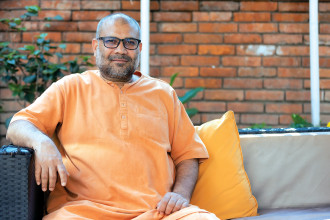
Hailing from Syangja, the President of Garment Association of Nepal Chandi Prasad Aryal has been in the garment business since 1978. He began his journey in this sector when he applied for a three-year fashion designing, textile and garment course in India. “My uncle was working in Japan Information Centre in India and I went there to get involved in anything that I saw scope in. The textile and garment business intrigued me and I joined the three-year course there,” says Aryal.
On returning from India, Aryal saw the viability for garment business in the country and opened factories with various partners with a focus on exports.
In his current position as President of GAN, he is working with policy makers and ministries to find ways to uplift the garment business in Nepal.
In an interview with Dibesh Dangol of B360, Chandi Prasad Aryal talks about the current challenges of the Nepali garment industry, the affect of the pandemic on this sector, and reasons for the industry to be unable to compete in international markets. Excerpts:

Can you provide the statistics of the garment industry of Nepal for 2019/20 and 2018/19?
In 2018/19, garments worth Rs 6.37 billion were exported whereas in 2019/20 the amount decreased to Rs 4.87 billion. Bangladesh is the second-largest garment manufacturing and exporting country after China. Currently, there are about 6000 garment factories in Bangladesh indicating an increase of almost 1500 factories compared to 2018. They are also manufacturers and exporters of leading clothing and fashion brands. Whereas in Nepal, there are just 103 readymade garment manufacturers and exporters at present as per the Ministry of Commerce website.What is hindering the Nepali garment industry from competing in the international market?
The answer to this question is in the interest of every Nepali. Nepal and Bangladesh got into the garment industry at the same time. Our business began from India and South Korea as they were the major importers of readymade Nepali garments. We were well ahead of Bangladesh during the start of the garment business. Yet the question remains: why did our garment business falter and theirs prosper. Bangladesh currently exports readymade garments worth $34.52 billion, four million people are directly involved in this business, and they have targeted reaching $50 billion by 2022. Though Bangladesh is just a tad bigger than Nepal, they are leaps and bounds ahead of us in the garment business. What do they have that we don’t? The direct access to the sea is their main plus point. But it is not all. The Bangladesh garment industry has full support from their government. In Nepal, this importance wasn’t given to the garment business by the private sector or the government. Currently, Bangladesh is focused on creating their raw materials whereas we are still importing raw materials from neighbouring countries. They are not just exporting readymade garments but also raw materials to various countries. Because we are importing raw materials, the final product is expensive than the countries which make raw materials as well as the final product. In terms of numbers, we are 15-18% more expensive than them which is a drawback while competing in the international market. Also, majority of orders that come to Nepal are rejected orders from other manufacturing countries for embroidery, beadwork, etc. These are time consuming as well as low paying works but we are obliged to accept it because something is better than nothing. When I came into this business, we had huge garment factories like Hetauda Kapada Udhyog and Balaju Kapada Udhyog. In 2001/02, there were 1,200 garment factories, 576 readymade garment exporters and the sector was employing 400,000 people. There were also washing, embroidery, labelling, poly-bagging and tagging plants established in Nepal. But because of unfriendly policies and the industry not receiving support from the government it led to the downfall of the industry here in Nepal. Though it is said that China is the number one exporter of the readymade garments, I would say that Bangladesh is ahead of China. In Bangladesh, the government provides whatever is necessary for the garment businesses. They have thus been able to generate huge domestic employment opportunities, whereas because of poor industrial development in Nepal, Nepalis have been forced to go to foreign countries to seek employment opportunities.
We were well ahead of Bangladesh during the start of the garment business. Yet the question remains: why did our garment business falter and theirs prosper. Bangladesh currently exports readymade garments worth $34.52 billion, four million people are directly involved in this business, and they have targeted reaching $50 billion by 2022. Though Bangladesh is just a tad bigger than Nepal, they are leaps and bounds ahead of us in the garment business. What do they have that we don’t?
What is GAN doing to solve these challenges?
First and foremost, the industry needs full support from the government. We import 700-750 million worth of raw materials every year. Some interested people want to set up mills to produce these raw materials but they need support from the government. Next thing that we hear most from our clients is about Nepal’s political disturbances. There should be no political disturbances in the country because it will directly or indirectly hamper all industrial sectors. We want to organise a garment sourcing fair in Nepal for which we need the help of the government so that buyers can come to Nepal, experience Nepal and see our products. It will be a great opportunity to showcase the possibility of Nepal to the world. We have heard that in the current budget a certain amount has been set aside for the garment industry for which we are grateful and consider it as a positive sign for the future of the garment industry. Also, while going to participate in international fairs, we want the government to provide incentives or share the expenses with the participating garment businesses because it is not just the garments that we are showcasing at the fairs, we are representing Nepal as well. We have been lobbying and advising the government to bring out policies to support and help the garment sector. We have also been providing necessary assistance to people involved in garment business if they are in difficulties.Majority of people currently working in Nepali garment industry are Indian migrant workers. Why isn’t Nepali manpower working in this industry?
If you look at the current workforce situation in the garment industry, the majority of manpower is Nepalis because now Nepalis are beginning to understand the importance and scope of the garment industry and they are skilled as well. Before, the majority were Indians because we didn’t have skilled Nepali manpower. We have been providing various skill-based manufacturing trainings to generate skilled manpower and are providing necessary advice to people involved in wholesaling, retailing or exporting of Nepali garments. The Ministry and the government should prioritise this sector and encourage people to get involved. They should provide necessary incentives in terms of lower interest rate to people who want to start a garment business. In terms of the labour force, they can work with us to create skilled manpower through various trainings so that Nepalis can view this as a good employment opportunity rather than opting for foreign employment.In 2001, 1200 manufacturing units were operational in Nepal but after the expiry of the World Trade Organisation’s Agreement on Textiles and Clothing (ATC) in 2005, the number has declined. Your comments.
The World Trade Organisation’s Agreement on Textiles and Clothing (ATC) started in 1995 for the duration of a 10-year transitional period and on January 1, 2005 the agreement ended. During these ten years, businesses were booming all over the world. The thriving garment business attracted many entrepreneurs. But after the end of the WTO’s agreement, the prices of garments produced in Nepal became expensive mainly because we had to purchase raw materials from other countries and there was no particular agreement protecting garment manufacturers and exporters. Thus, many garment factories began to shut down. The then government of Nepal also didn’t take the right steps like signing bilateral trade agreements with countries from which raw materials were being imported. If they had done so, we would have been protected and supported and the garment industry could have prospered. There is no particular guideline or system that the Nepali garment manufacturers and exporters have to abide by in Nepal while dealing or signing agreements with their clients. Everybody deals with their client in their own way. The basics while signing an agreement include price negotiation, manufacturer/exporter taking orders from clients, and delivering the finished products to clients on time.The Covid 19 pandemic has hit Nepal’s readymade garment sector hard and is reportedly facing Rs 1.25 billion hit as foreign buyers have cancelled their orders. What is the current situation?
Foreign buyers haven’t completely cancelled the order of Rs 1.25 billion. Because of the travel ban and lockdown that we are experiencing we haven’t been able to supply them the final products and everybody from the manufacturers and exporters to the manpower involved in the garment industry are in an uncertain state. But the fact remains that whether the buyers purchase or don’t purchase the products, we have already taken a hit of Rs 1.25 billion. The current government is positive in taking the Nepali garment industry forward. If we had asked for ten things, the government is positive in fulfilling three to four of our requests. The main thing that we want from the government is to provide us with cash incentives and grants of 10-15% so that our final products can be cheaper and we can compete with others in the international market. The foreign buyers are ready to work with Nepali garment manufacturers and exporters because of our hard work, dedication and honesty but the cost factor has been demotivating them. The government has issued a statement to provide cash incentives and grants for the Nepali clothing sector but the garment sector has been excluded. Our request to the government is to include the garment sector in that incentive and grants as well so that the sector, manpower, manufacturers and exporters can grow.
Published Date: September 14, 2020, 12:00 am
Post Comment
E-Magazine
RELATED Face 2 Face





